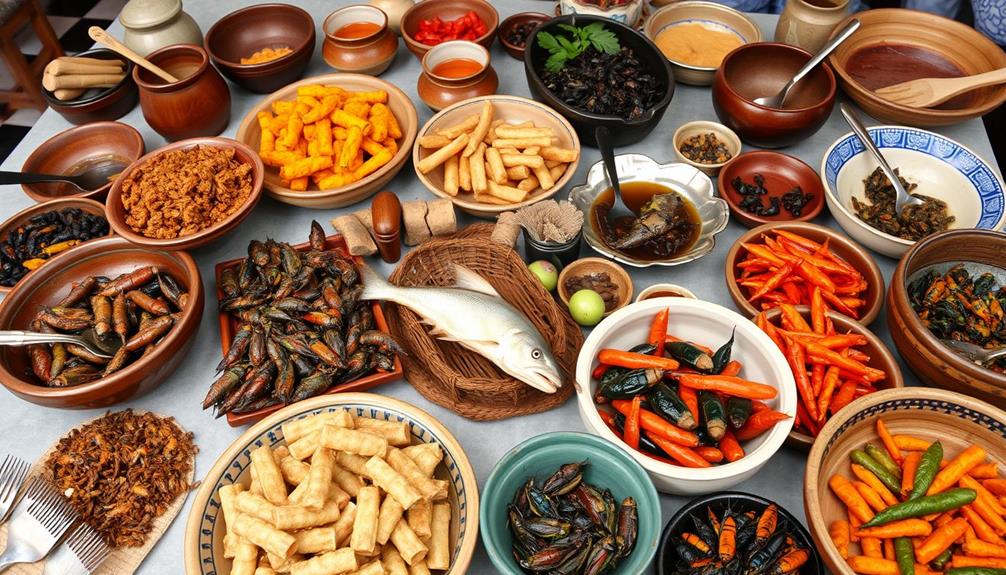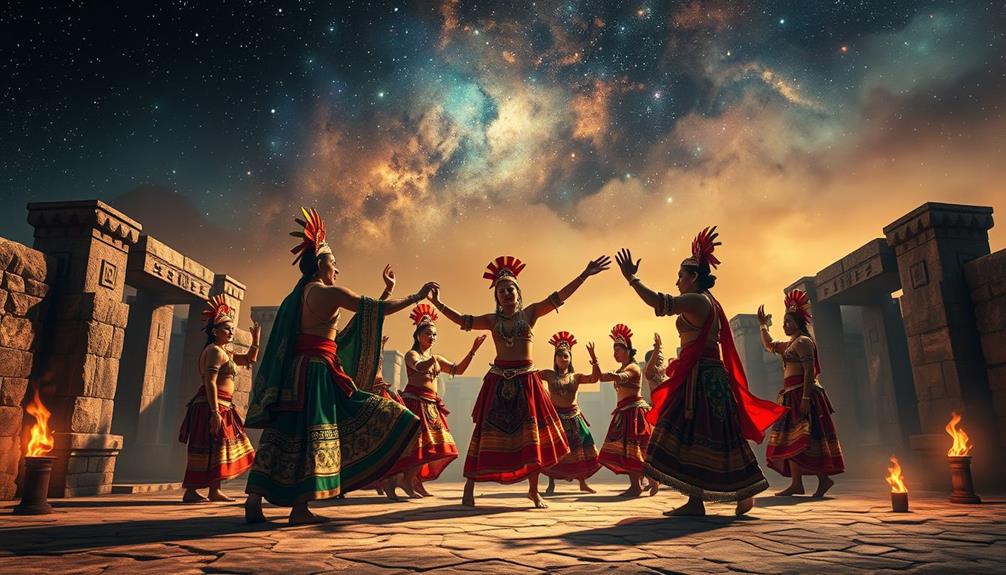Unusual traditions from around the globe highlight the creativity and diversity of human cultures. You might find yourself fascinated by Spain's La Tomatina, where people throw tomatoes for fun, or the Monkey Buffet Festival in Thailand, where macaques feast on lavish spreads. Consider the strange yet mesmerizing Famadihana in Madagascar, where families dance with their ancestors' remains. Then there's the whimsical Danish tradition of cinnamon dousing for singles turning 25. These rich customs celebrate joy, community, and connection, reflecting values that transcend borders. There's so much more to explore, and you won't want to miss what's next!
Key Takeaways
- La Tomatina in Spain involves a massive tomato-throwing party, fostering community spirit and vibrant chaos every August.
- The Monkey Buffet Festival in Thailand offers a feast for macaques, symbolizing gratitude and good luck on the last Sunday of November.
- In Madagascar, families participate in the Famadihana Ceremony, dancing with ancestors' remains to celebrate life and honor memories.
- The Cheese Rolling Festival in England features participants chasing a rolling wheel of cheese down a hill, creating a fun and competitive atmosphere.
- The Day of the Dead in Mexico is a colorful celebration with altars and offerings that honor deceased loved ones, emphasizing cultural connections to the past.
Unique Cultural Practices
Across the globe, unique cultural practices showcase the rich diversity of human expression and tradition. You'll find unusual traditions that highlight the creativity and spirit of communities.
For instance, La Tomatina in Buñol, Spain, draws thousands who gather for an epic tomato-throwing battle, transforming the streets into a vibrant sea of red each August. This playful chaos offers a unique glimpse into Spanish culture. Curiously, such community events can foster a sense of belonging and emotional connection, much like the dynamics found in narcissistic relationships, where emotional dependence plays a significant role in interactions the dynamics of narcissist-codependent relationships.
In Lopburi, Thailand, the Monkey Buffet Festival celebrates local macaques with a lavish feast, where people gather to share fruits and vegetables, believing it brings good luck and prosperity.
Similarly, in Castrillo de Murcia, Spain, the Baby Jumping ritual, known as El Colacho, sees men dressed as devils jump over infants on mattresses, symbolizing protection from evil spirits.
These unique cultural practices reflect how traditions around the world help communities connect and honor their heritage.
The Famadihana ceremony in Madagascar, where families dance with their ancestors' remains, and the Dani tribe's finger-cutting ritual in Indonesia both illustrate deep cultural ties to grief and remembrance. Each tradition tells a story about the values and beliefs that shape these communities.
Unusual Marriage Customs

Cultural practices don't just celebrate community; they also shape personal relationships, especially through marriage customs that vary dramatically around the world. Unusual marriage customs can reflect deep-rooted traditions from around the globe, often surprising those unfamiliar with them.
These customs can even influence how individuals view attractiveness and compatibility, as some cultures intertwine astrological beliefs with their marriage practices.
Consider these unique practices:
- In certain regions of India, brides are auctioned off to the highest bidder, showcasing a complex view of value and relationships.
- The Maasai tribe in Kenya requires warriors to steal a cow to win a bride, highlighting bravery as a key trait.
- South Korean women turning 30 experience a "mock funeral," symbolizing the end of their single life and the societal pressure to marry.
- In China, bride kidnapping has been an age-old custom, albeit now less common due to evolving laws.
These unusual marriage customs reveal how cultural practices shape the way people view love and commitment. Each tradition carries a story, reminding us of the diverse ways communities define relationships.
As you learn about these practices, it's hard not to feel a mix of fascination and reflection on your own customs surrounding marriage.
Strange Food Traditions

When you explore strange food traditions, you'll encounter unique delicacies that reflect cultural significance and adventurous eating experiences.
For instance, the vibrant world of candy includes unusual varieties like Pez candy filling techniques that showcase creativity in confectionery.
From Iceland's hákarl to the Philippines' balut, these foods tell stories about the people and places they come from.
Are you ready to expand your palate and discover what these dishes reveal about their cultures?
Unique Delicacies Worldwide
Unique delicacies from around the world reveal the fascinating—and sometimes shocking—culinary practices that define different cultures. These unique delicacies worldwide often provoke strong reactions, whether of curiosity or disbelief.
The intense emotional experiences associated with trying new foods can mirror the complexities of relationships seen in BPD-coded characters and their struggles with identity. Here are a few examples that highlight the extraordinary food traditions you might encounter:
- Iceland's hákarl: Fermented shark with a pungent ammonia smell that requires an acquired taste.
- Japan's fugu: A highly prized pufferfish dish that can be deadly if not prepared by licensed chefs.
- The Philippines' balut: A fertilized duck egg with a developing embryo, often enjoyed as street food.
- South Korea's sannakji: Live octopus served still squirming, offering a truly adventurous dining experience.
In addition to these, the Yanomami tribe in Venezuela consumes a soup made from the bones of deceased loved ones. This practice connects them with their ancestors and brings peace to the afterlife.
Each of these unique practices around the world reflects the rich cultures and traditions that shape our understanding of food and its role in society. Are you brave enough to try them?
Cultural Significance of Food
Food goes beyond mere sustenance; it embodies the traditions and beliefs of a community. In various cultures, unique food practices highlight their historical and cultural significance.
For instance, in Iceland, hákarl, or fermented shark, showcases resilience and adaptation, often accompanied by schnapps to soften its pungent flavor. The Japanese treat fugu, a potentially deadly pufferfish, reflects the deep respect for culinary mastery, as chefs must undergo extensive training to prepare it safely.
Notably, some cultures believe that astrology claims to influence personality traits linked to attractiveness, which can affect how food is presented and consumed during social gatherings.
In the Philippines, balut, a fertilized duck egg, serves as a popular street food and symbolizes nourishment, while South Korea's sannakji, live octopus served still wriggling, emphasizes the importance of freshness and culinary daring.
Perhaps most striking is the Yanomami tribe's practice of making soup from the bones of their deceased relatives. This unique dish honors their ancestors, showing a profound connection between food, memory, and cultural identity.
Through these unusual food traditions, you can see how communities express their values and beliefs. Each bite tells a story, reinforcing the cultural significance of food and its role in shaping identities worldwide.
Adventurous Eating Experiences
Many adventurous eaters seek out strange food traditions as a way to explore different cultures and push their culinary boundaries. The experience of tasting unique dishes can be akin to enjoying a rich Americano coffee with bold flavors.
If you're ready to immerse yourself in a world of unusual flavors, here are some daring dishes you might want to try:
- Fermented shark (hákarl) from Iceland, notorious for its strong odor, usually pairs well with a shot of aquavit.
- Fugu, the infamous pufferfish in Japan, is a thrilling experience but requires a licensed chef to serve it safely—one wrong cut could be deadly!
- Balut, a fertilized duck egg from the Philippines, is a popular street food that you can eat straight from the shell, offering an unforgettable texture and flavor.
- Live octopus (sannakji) in South Korea is served while still squirming on your plate, making for a truly unique dining adventure.
These dishes not only challenge your palate but also connect you to the stories and traditions of their cultures.
Bizarre Festivals

Across the globe, bizarre festivals showcase humanity's playful spirit and creativity in the most unexpected ways. In Buñol, Spain, La Tomatina invites you to join thousands in an epic tomato-throwing battle, transforming the streets into a vibrant, squishy mess every last Wednesday of August.
These gatherings often create strong community bonds, much like how cats exhibit signs of attachment similar to dogs. If you fancy furry friends, head to Lopburi, Thailand, for the Monkey Buffet Festival. Here, you'll witness a lavish feast laid out for local macaques, celebrating their role as bringers of good luck every last Sunday of November.
Another unique event is the Battle of the Oranges in Ivrea, Italy, where you'll cheer on nine teams hurling oranges at one another in a spirited reenactment of a historical uprising.
If you want something a bit egg-centric, the Festival of Scrambled Eggs in Zenica, Bosnia, serves up a massive breakfast to herald the arrival of spring.
And don't forget the Cheese Rolling Festival in Gloucestershire, England, where participants chase a rolling wheel of cheese down a steep hill for a chance to win the cheese itself—despite the risks!
These bizarre festivals reflect strange traditions that bring communities together in joyful celebration.
Odd Superstitions

Delving into the domain of odd superstitions reveals a fascinating tapestry of beliefs that shape behaviors worldwide. These superstitions often reflect cultural values and fears, creating unique rituals aimed at attracting good luck or warding off misfortune.
Much like the emotional complexities found in relationships, superstitions can serve as a means of coping with uncertainty, guiding individuals through life's unpredictable moments. For instance, just as recognizing emotional pain is essential for healing after a breakup, understanding superstitions can provide comfort and a sense of control over one's environment.
Consider these intriguing examples from around the globe:
- In Russia, breaking a mirror can mean seven years of bad luck, tied to ancient views on reflection and the soul.
- Italians regard the number 17 as unlucky, often avoiding important events or changing travel plans to dodge its influence.
- In Japan, sleeping with a fan on is feared to be fatal, leading to the chilling term "fan death."
- Turkish culture embraces the evil eye, prompting the use of protective charms, or "nazar," to fend off negativity.
These odd superstitions shape how you navigate daily life, reminding you of the deep-rooted beliefs that persist across cultures.
Whether you're avoiding a black cat or steering clear of mirrors, you're not alone in your quest for good luck—people around the world share these peculiar practices, highlighting the universal human desire to control fate.
Uncommon Burial Practices

The way cultures handle death often reflects their beliefs and values, much like the odd superstitions that guide daily life. In Tibet, you'll find Sky Burials, where the deceased are placed on mountaintops for vultures to consume. This practice symbolizes the belief that the body is just a vessel, returning to nature.
Notably, similar to the practices in herbalism, many cultures utilize natural elements in their burial traditions, illustrating a profound connection to the earth and its cycles for support and networking. In Madagascar, the Famadihana tradition, or "turning of the bones," involves exhuming ancestors' remains every few years, wrapping them in fresh shrouds, and dancing with them to celebrate familial connections.
Traveling to Indonesia, you'll encounter the Toraja Funeral Practices, known for their elaborate ceremonies that can last several days. These rituals include music, feasting, and displaying the deceased in their homes, showcasing deep respect for the dead.
Meanwhile, in New Orleans, high water tables lead to unique Above-Ground Tombs, often artistically decorated, reflecting the city's rich cultural heritage. These uncommon burial practices not only highlight diverse beliefs about death but also emphasize the profound connections communities maintain with their departed loved ones, reminding us that death is as much a part of life as any other experience.
Whimsical Celebrations

Whimsical celebrations bring a splash of joy and creativity to cultures around the world, showcasing how communities embrace fun in their traditions. From lively festivals to playful rituals, these events often center around laughter and togetherness.
In the spirit of caregiving, it's important to foster social connections to combat loneliness, much like the joy found in these celebrations, as seen in caregiver support resources.
In one place, the Monkey Buffet Festival in Lopburi, Thailand, highlights a feast for thousands of macaques, believed to bring good luck to the community. Meanwhile, in Denmark, there's a quirky cinnamon tradition where unmarried folks turning 25 get doused in cinnamon, creating a light-hearted moment amidst aging.
Other festivals showcase culinary delights, like the Festival of Scrambled Eggs in Zenica, Bosnia, where a massive breakfast marks spring's arrival.
And who could forget the exhilarating La Tomatina in Buñol, Spain? This famous tomato fight transforms the streets into a vibrant, messy wonderland of laughter and camaraderie.
Here's a glimpse of these whimsical celebrations:
- Monkeys enjoying a lavish feast
- Singles playfully covered in cinnamon
- Scrambled eggs shared in community spirit
- A chaotic yet joyful tomato fight
Each celebration invites you to embrace the joy and imagination that unites us all.
Historical Rituals

When you explore historical rituals, you'll see how deeply they connect cultures to their past.
These rites of passage not only mark significant life changes but also honor ancestors and their memories in unique ways.
For instance, the significance of astrology in various cultures often mirrors the influence of these rituals on personal identity and relationships, revealing how astrological traits influence attractiveness.
From the excruciating Bullet Ant Initiation to the poignant practice of finger cutting, each tradition carries profound cultural significance.
Cultural Significance of Rituals
Rituals hold immense cultural significance, often serving as a bridge between generations and a means of expressing collective identity. They connect you to your roots, offering a glimpse into shared values and beliefs.
Consider some powerful examples:
- Famadihana in Madagascar, where families dance with their ancestors' remains, celebrating life and memory.
- The haunting Finger Cutting ritual practiced by the Dani tribe in Indonesia, where grief manifests in physical form as women amputate their fingers to honor the deceased.
- The grueling Bullet Ant Initiation in Brazil, a rite of passage for young men demonstrating their resilience through painful ant stings, marking their shift to adulthood.
- Sky Burials in Tibet, where bodies are left for vultures, reflecting a profound respect for the cycle of life and death.
These rituals reveal how cultures navigate emotions, honor memories, and forge connections.
Through these practices, people express love, loss, and the spirit of community, reminding you that traditions aren't just remnants of the past; they shape the identity of future generations.
Rites of Passage
Throughout history, rites of passage have marked significant changes in people's lives, serving as powerful cultural milestones. One of the most striking examples is the Ant Initiation of the Satere-Mawe tribe in Brazil. In this intense ceremony, young men wear gloves filled with bullet ants, known for delivering extremely painful stings. This test of strength and resilience is vital for moving into adulthood and embracing tribal responsibilities.
In contrast, the Dani tribe in Indonesia showcases their unique rites of passage through a grief ritual. Women amputate the top joint of their fingers as a symbol of their pain and connection to deceased family members. This act reflects profound cultural significance, turning personal loss into a shared community experience.
These examples highlight the diverse ways cultures navigate life's pivotal moments. Whether it's enduring the excruciating pain of bullet ants or expressing grief through physical sacrifice, rites of passage serve as fundamental markers of identity and belonging.
They not only define personal growth but also reinforce communal ties, showcasing the intricate balance between individual experiences and cultural heritage.
Honoring Ancestors' Memory
Honoring ancestors' memory is a deeply rooted practice in many cultures, emphasizing the importance of remembering those who've passed. Various rituals around the world showcase this commitment, each reflecting unique beliefs and values.
Consider these poignant traditions:
- Famadihana in Madagascar, where families dance with their ancestors' remains, celebrating life and connection.
- The Nagoro Doll Village in Japan, where artist Ayano Tsukimi creates dolls representing former residents, reminding the living of those who've come before.
- The vibrant Day of the Dead in Mexico, featuring colorful altars and offerings that celebrate the lives of loved ones.
- The somber finger cutting ritual among the Dani tribe in Indonesia, symbolizing the profound pain of loss.
These practices reveal how cultures honor ancestors, blending mourning with celebration. They remind you that remembering isn't just about sorrow; it's about maintaining a bond with those who shaped your history.
In each tradition, you see a deep respect for the past, showing that honoring ancestors is an essential thread in the fabric of human experience.
Regional Traditions

Celebrating local customs can reveal fascinating insights into a culture's values and history. One notable tradition is Denmark's cinnamon celebration, where unmarried folks turning 25 get doused in cinnamon by their friends and family. It's a playful way to highlight their single status and bring laughter to the occasion.
In Bosnia, the Festival of Scrambled Eggs, or Čimburijada, welcomes spring with a communal breakfast in a park, where everyone enjoys scrambled eggs together, symbolizing unity and new beginnings.
Meanwhile, Thailand hosts the annual Monkey Buffet Festival in Lopburi, where locals prepare a lavish feast of fruits and vegetables for macaques, honoring their role in bringing good luck.
Spain's La Tomatina festival transforms the streets of Buñol into a vibrant sea of red every final Wednesday of August, as participants hurl overripe tomatoes at each other, showcasing a unique form of community engagement and joy.
Finally, Germany's Polterabend involves friends and family breaking pottery and other items before a wedding, creating noise believed to bring good luck to the couple.
Each of these traditions reflects the local culture's spirit and values, making them truly special.
Conclusion
Exploring these unusual traditions, you find a world where love and laughter coexist with the bizarre and the macabre. From quirky marriage customs that defy logic to food practices that challenge your palate, each cultural quirk reveals a deeper connection to humanity. As you reflect on these rituals, you realize that what seems odd from one perspective can be a cherished celebration from another. Embrace the beauty in our differences; they're what make our shared experience so rich and vibrant.









